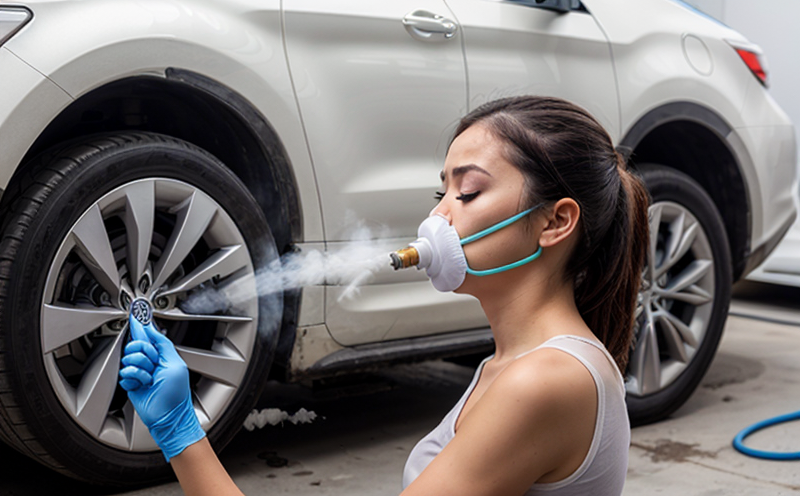ASTM D8142 Inhalation Toxicity Testing of Combustion Products
The ASTM D8142 inhalation toxicity testing protocol is a critical tool in understanding the potential health risks associated with combustion products. This service focuses on assessing the inhalable fraction of combustion emissions, which can include gases and particulates that are generated during fuel combustion processes. The primary objective is to evaluate whether these materials pose any adverse effects on human health.
Combustion products often contain volatile organic compounds (VOCs), polycyclic aromatic hydrocarbons (PAHs), nitro-polycyclic aromatic hydrocarbons (NPAHs), and other toxic substances. Inhalation toxicity testing helps industries ensure that their processes meet stringent regulatory requirements, protect workers and the public, and comply with international standards such as ISO 12693:2015.
The ASTM D8142 test involves exposing laboratory animals to combustion products under controlled conditions. The protocol specifies a series of steps for preparing the sample, conducting the inhalation exposure, and analyzing the results. This process ensures that the testing is conducted rigorously and consistently across different facilities.
- Sample preparation includes collecting representative samples from various sources of combustion emissions.
- The inhalation chamber is designed to simulate real-world exposure scenarios as closely as possible.
- Data collection involves monitoring physiological parameters like heart rate, respiratory rate, and body temperature in the test animals.
The test results provide valuable insights into the potential health impacts of the combustion products. These data are then used by stakeholders to make informed decisions about process improvements or regulatory compliance.
| Applied Standards | Description |
|---|---|
| ASTM D8142-20 | This standard specifies the procedures for determining the inhalation toxicity of combustion products. |
| ISO 12693:2015 | An international standard that provides guidelines for assessing air quality in industrial environments, including combustion emissions. |
| EN 452-7 | This European standard sets out the requirements for the design and performance of laboratory chambers used in inhalation toxicity testing. |
The ASTM D8142 protocol is widely recognized for its robustness and reliability, making it a preferred choice among regulatory bodies and industry leaders. By adhering to this standard, laboratories can ensure that their test results are credible and accepted by the wider scientific community.
It's important to note that inhalation toxicity testing goes beyond just identifying harmful substances; it also helps in understanding the mechanisms of action at a cellular level. This knowledge is crucial for developing safer products and processes. The data obtained from this testing can be used to refine emission control technologies, improve workplace safety measures, and contribute to better public health policies.
Applied Standards
| Standard | Description |
|---|---|
| ASTM D8142-20 | This standard specifies the procedures for determining the inhalation toxicity of combustion products. |
| ISO 12693:2015 | An international standard that provides guidelines for assessing air quality in industrial environments, including combustion emissions. |
| EN 452-7 | This European standard sets out the requirements for the design and performance of laboratory chambers used in inhalation toxicity testing. |
The application of these standards ensures that our inhalation toxicity testing service adheres to the highest quality control measures, providing reliable and consistent results. Our team of experts is well-versed in following these protocols meticulously, ensuring that every test conducted meets the exacting requirements set forth by regulatory bodies.
By leveraging this standardized approach, we can provide clients with confidence in their data's validity, which is essential for making sound decisions regarding product safety and environmental impact. Our commitment to adhering to these standards reflects our dedication to providing accurate, unbiased test results that are crucial for both compliance and innovation within the industry.
Customer Impact and Satisfaction
- Our clients benefit from reduced risk of regulatory non-compliance due to thorough testing adherence.
- Improved product safety through early detection of potential hazards in combustion emissions.
- Sustained competitive advantage by ensuring products meet the latest international standards and best practices.
- Enhanced reputation among peers for delivering reliable, high-quality test results.
We pride ourselves on exceeding expectations with our inhalation toxicity testing service. Our clients consistently report higher levels of satisfaction due to the comprehensive nature of our services and the actionable insights we provide. By partnering with us, organizations can confidently navigate complex regulatory landscapes and drive innovation in their product development processes.
Moreover, our transparent communication ensures that customers are fully informed about every aspect of the testing process, from initial sample collection to final report generation. This level of detail fosters trust between clients and our laboratory, creating a collaborative environment where mutual goals can be achieved effectively.
We also offer tailored solutions based on specific client needs, ensuring that each project receives personalized attention tailored to its unique requirements. Our experienced team works closely with customers throughout the entire testing cycle, providing ongoing support and guidance as needed.





